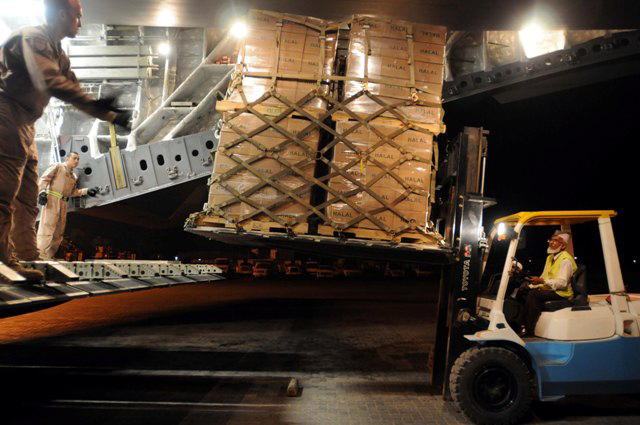A pallet loaded with heavy cargo is airdropped from a C-130 Hercules aircraft during tactical airdrop training flight. Look closely at the rollers/rails on the aircraft. The Metapallet, at 88 inches is twenty inches narrower than the 463L, but would still fit on the rollers of the C30 with additional guide rails.
The Metapallet is designed to solve the Seal-Land-Air intermodal problems and to add civilian multimodal aspects as well, seeking to be a true “Omnimodal” freight system.
The core idea involved here is utilize the basic framework of the 463L with a slightly smaller dimensioned pallet, one that will maintain the strength and durability while increasing the multimodal and automation capabilities.
The 463L is intended for use with air freight and designed to speed loading from one end of the cargo area of a freight carrying aircraft not unlike the loading of standard ocean containers in warehouses, or road freight trailers used universally on national highways. The concept of end loading and the equipment designs used by the aircraft industry can be equally applied to ocean containers and truck trailers when the smaller dimensioned Metapallet is used.
The 7’4″ width works better for on the road applications since it fits within the interior dimensions of ocean containers and also allows enough space for additional road trailer enclosures to secure the loads from threats. The 6’4″ depth allows for a 40′ trailer or container to hold six units without difficulty.
- MetaPallet is 76 inches x 88 inches by 2.25 inches thick. The Metapallet will have many additional features to help with its many other applications.
- 463 L Master Pallet is 88 inches by 104 inches by 2.25 inches thick.
About the 463L Master Pallet
Due to the proven track record of the 463L it makes sense to utilize the engineering of the 463L as a foundation for its application development.

A 463L pallet accommodating 8 stacked standard pallets
Intermodalism is the use of several modes of transportation to accomplish a single movement of cargo. A shipment is intermodal primarily by virtue of its physical characteristics. For example, cargo loaded into a container is moved by truck, then by vessel, and finally by train to its final destination. Intermodal may also be a contractual description. In this case a carrier may subcontract portions of the move, while presenting the shipper with a single Bill of Lading under which the move is performed. In contrast to the separate evolution of the laws of common carriage by land and by sea, ocean intermodalism developed as a result of land based transportation practice, not separate from it.
One major challenge is the inter-modal problem; that is, sealift and land utilize 20- or 40-foot containers, and airlift requires 463L pallets.
The military system relies heavily on the 88″ X 108″ pallets of the 463L Materials-Handling System. The civil system relies to a greater extent on containers and the 88″ or 96″ X 125″ civil pallets.
The 463L cargo system includes a pallet of metal sandwich construction specifically designed for palletizing and transporting air cargo on roller type conveyors in the terminal, restraint rails and roller conveyors in the aircraft and cargo loading and unloading vehicles. It is equipped with locking arrangement for locking the pallet into the aircraft rail system for restraint during flight and tie-down rings to secure the NET, CARGO TIE-DOWN, AIRCRAFT PALLET. Excludes PALLET, MATERIAL HANDLING.
The 463L pallet is made of corrosion-resistant aluminum with a soft wood or fiberglass core and is framed on all sides by aluminum rails. The rails have 22 tie-down rings attached with 6 rings on each long side and 5 rings on each short side. Each ring has a 7,500-pound restraint capacity. The rails also have indents (notches) that accept the detent locks located on numerous types of materials-handling equipment and on all airlift-capable aircraft. The overall dimensions of the 463L pallet are 88 inches long by 108 inches wide by 2 1/4 inches thick. However, the usable dimensions of the upper surface are 84 inches wide by 104 inches long. This allows 2 inches around the periphery of the pallet to attach straps, nets, or other restraint devices. An empty 463L pallet weighs 290 pounds (355 pounds with a complete set of nets) and has a maximum load capacity of 10,000 pounds. The maximum pounds per square inch for the 463L pallet is 250 pounds. If a load exceeds this limitation, then shoring must be used to spread the load over a larger area.

Figure 18-1. View of rails and indent on 463L pallet CONSTRUCTION OF 463L PALLETS. The 463L pallet dimensions are 108 inches by 88 inches by 2 1/4 inches. It weighs 337 pounds and has a total load capacity of 10,000 pounds. The desired load capacity is 7,500 pounds. The pallet has a balsa wood core, and is covered with corrosion-resistant aluminum. It is framed on all sides by aluminum rails which have 22 tie-down rings attached with six rings on each of the long sides and five rings on each of the short sides. The rails also have indents (notches) which can accept rail locks when the pallet is put on an aircraft (Figure 18-1). The C-130 and C-141 aircraft are fitted with a dual-rail system. The rails are fitted with detents (rail locks) to lock the pallet in place. These detents prevent forward and aft movement of the pallets while the aircraft is in flight. The usable dimensions of the 463L pallet are 104 inches by 84 inches. Four inches around the pallet are used to secure the straps, nets, or chains.
